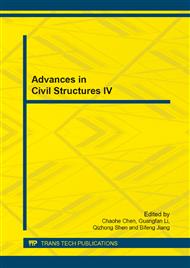[1]
Y.P. Peng, M. Ma, Y.Q. Wang: Anhui Architecture, (2009) No. 06, P. 56-57. (In Chinese).
Google Scholar
[2]
X.H. Li: Sichuan Building Science, (2009) No. 01, P. 105-107. (In Chinese).
Google Scholar
[3]
X.D. Zhang: Reinforced Concrete Structures Crack Control Proceedings ( 2004 . (In Chinese).
Google Scholar
[4]
T.M. Wang: Engineering Structure Crack Contro (China Building Industry Press, 1997). (In Chinese).
Google Scholar
[5]
H. Sun: Technologies Wind, (2010) No. 03, P. 156-157. (In Chinese).
Google Scholar
[6]
S.Y. Cao, H.X. Qiu and W.H. Hua: China Water Resources and Hydropower Publisher, (2002).
Google Scholar
[7]
Ministry of Housing and Urban-Rural Development of the People's Republic of China:, Reinforced concrete structure design code (GB 50367-2006)( China Building Industry Press, China 2006). S (In Chinese).
Google Scholar
[8]
X.Y. Hu: Large Scale Floor Structure Temperature Effect Analysis and Crack Control Method (Master, Huazhong University of Science and Technology China 2005) . (In Chinese).
Google Scholar
[9]
C. Wang: The Study of the Concrete Structure Crack Control of the Changchun City Construction Engineering (Master, Jilin University China 2007). (In Chinese).
Google Scholar
[10]
X.F. Yu: Journal of Zhe Jiang Water Conservancy and Hydropower College, (2006)No. 01, P. 1-4. (In Chinese).
Google Scholar
[11]
X.P. Can, Y.M. Zhu and H. Ben: Journal of Water Conservancy (2009)No. 06, P. 969-975. (In Chinese).
Google Scholar
[12]
Y.S. Jen, S.P. sha: Journal of Building Structures and Practices (2010) No. 05, P. 204-212. (In Chinese).
Google Scholar


